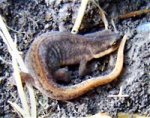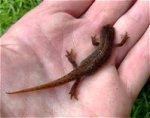A few hours spent doing some manual work in the garden yielded a couple of unexpected new animals: a flatworm and a newt.
I noticed the flatworm as it moved over the surface of a broken brick in one of the
habitat baskets I made for the pond. It was only a couple of centimetres long - it hardly looked more than a thin black smudge on the brick. The thing that really betrayed its identity was the way it moved. Not a trace of undulation in the body or any other movement gave away its means of locomotion; it seemed to be literally gliding over the surface of the brick. This type of movement is very characteristic of a flatworm. Not a very glamorous animal I know, but I get a genuine thrill every time I find more evidence of increasing biodiversity in the garden as a consequence of the techniques I'm using.
 This picture shows the newt more or less in the position where I found it under a large block of stone.
This picture shows the newt more or less in the position where I found it under a large block of stone.
For real 'glamour' though, you can hardly do better than a new vertebrate in the garden, so I was absolutely delighted when I uncovered this newt while moving some large blocks of stone.
This is either a common newt (
Triturus vulgaris), which is also called the smooth newt, or a palmate newt (
Triturus helveticus), but I don't have enough experience of them to be able to be more precise. The two species are easier to tell apart in the breeding season (particularly the males).
 Here is the newt in the hand where its small size is evident.
Here is the newt in the hand where its small size is evident.
I cannot even say whether or not this was a mature specimen. Palmate newts prefer more acidic pools that the common newt, but we are close enough to moorland here not to discount the possibility on that basis.
I had been considering introducing newts to my garden from the gardens of some friends this year, but it didn't happen. Now I am much more inclined to wait a few years to see whether my pond will be naturally colonised by them. Because I had disturbed the site where this one was holed up (completely removing the stone blocks), I relocated it to a more suitable part of the garden -
the space under the deck adjacent to the pond. When I built the deck I filled the space underneath with small logs, branches, stones and rubble in the hope of providing a sanctuary for a number of animals, and newts were at the forefront of my mind.